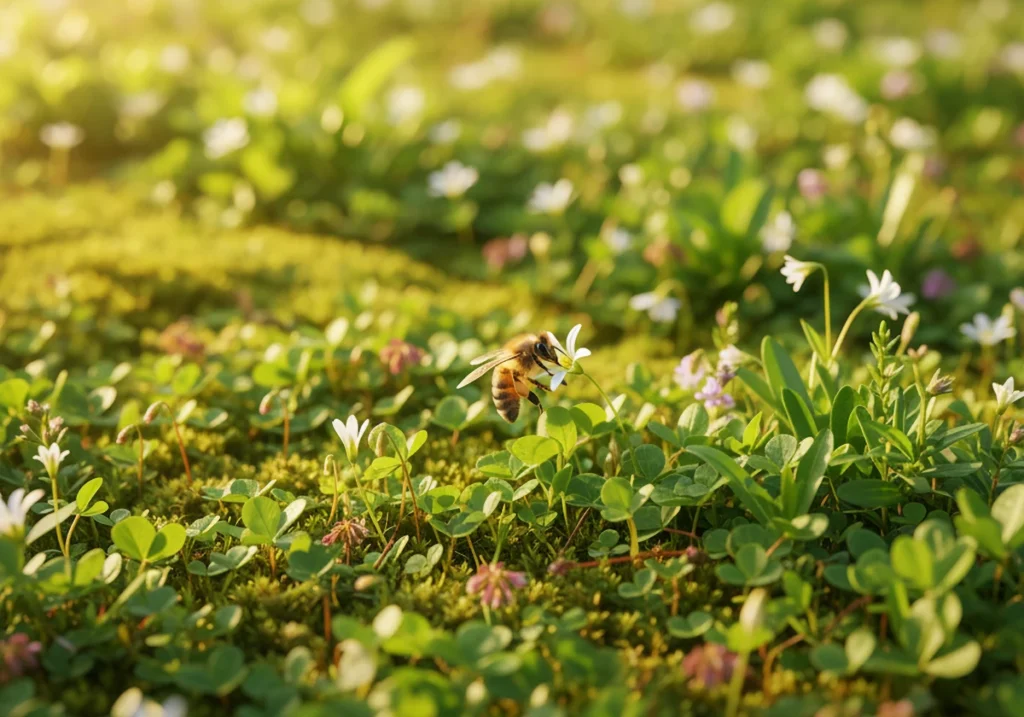If you’re here, that means you’re tired of meeting your lawn demanding attention every single weekend like it’s your date! You spend hours pushing a mower around the garden in summer heat, only to watch grass turn brown by February. Traditional turf lawns drink up water, call for constant mowing, and still manage to look patchy and tired.
The sad truth is, maintaining that “perfect lawn” costs more time than it should. It eats into your weekends, water bills, and energy. You deserve better than a second job on your precious weekends!
That’s where moss lawns and native groundcovers come in. These smart, sustainable alternatives look great year-round while bringing in:
- Low maintenance
- Water efficiency
- Wildlife-friendliness
- Cooler surface temperatures
- Cost-effective over time
You’ll soon find out how moss lawns and native groundcovers compare to traditional turf with real data on upkeep, costs, and cooling benefits. Native plants are worth their weight in gold. Moving away from traditional lawns isn’t just trendy, but a smart, sustainable choice.
What Makes a Good Lawn Alternative
Any plant that replaces traditional grass, but:
- Uses less water
- Less mowing
- Attracts pollinators
- Needs fewer chemicals to stay green (even in Aussie conditions!)
You want a ground cover that looks good year-round without stealing your date’s attention every weekend!
Matching Plants to Your Conditions
Let’s be real here, we’ve all tried to turn a fern into groundcover at some point and watched it fail miserably. The real trick is matching the right plant to your soil, light, and moisture levels. What you need to focus on is picking plants that actually belong in your space.

- Full sun lovers: Hardy species that handle drought-tolerant conditions and don’t mind baking in summer heat (i.e., Native violets and creeping boobialla)
- Shade dwellers: Plants that prefer partial shade and cooler spots under trees or along fence lines (i.e., Native ginger and kidney weed)
- In-between options: Versatile groundcovers that adapt to mixed light conditions throughout the day (i.e., Pigface and grevillea groundcovers)
Native species are your best bet because they’ve spent thousands of years adapting to Australia’s unique climate, soils, and seasons. Which means:
- Less watering and fertilising
- Fewer pests and diseases
- A healthier, more balanced garden with genuine low-maintenance care
How Native Groundcover Improves Urban Areas
After looking into dozens of Australian native species and their habitat benefits, one thing becomes crystal clear. Native groundcovers do far more for our cities than regular turf ever could.
These hardy plants develop deep root systems that stop soil erosion, filter stormwater, and keep your garden beds stable even after heavy rain. Their dense, living foliage naturally blocks weeds from taking over. You’ll start seeing the difference by the very first spring as fresh green growth fills in.
Key Benefits for Australian Gardens
Local species work harder for you than imported varieties. They’re practical powerhouses designed for our climate.
- Wildlife Support: Local species attract 3-4 times more native insects and birds than exotic turf. Walk through any established patch of native ground cover and you’ll spot butterflies, native bees, and small birds foraging. The beautiful pastel flowers on many native plants provide nectar sources that support local ecosystems.
- Less Work Required: Most native groundcovers only need fertilising once a year, compared to turf’s quarterly feeding schedule. They adapt naturally to your local soil and weather, which means you spend less time watering and trimming. You might need to pull a few weeds here and there during the first year, but maintenance drops to almost nothing after establishment.
- Environmental Impact: Native groundcovers create habitat for beneficial insects while using far fewer resources than lawn grass. The dense coverage protects soil from temperature extremes and keeps moisture locked in.
Together, these benefits make native groundcovers one of the smartest, most sustainable choices for Australian gardens.
Fighting Urban Heat Island Effect
If you’ve ever walked barefoot on the pavement in midsummer, you already know how Aussie cities get seriously hot. Urban areas become 2-5°C hotter than nearby rural regions. This urban heat island effect happens when dark surfaces absorb heat all day and then release it slowly at night.
This is as uncomfortable as it sounds, and it increases energy costs. It even heightens health risks during extreme heat, and every year, we’re watching cities break new temperature records.
Natural Climate Change Through Ground Cover
But you can have a natural air conditioner right in your yard! Dense groundcover plants can cool the ground by 10–15°C compared to bare soil.
Moss lawns hold moisture and release it slowly, naturally cooling the air around them. Native groundcovers allow shade to the soil and reduce how much heat radiates back into the environment. Together, they create microclimates that make outdoor spaces noticeably cooler, no electricity required.
So instead of reflecting heat like concrete, these living carpets actively reduce the urban heat island effect and make your space more comfortable.
Every garden that switches from grass to native groundcover makes a real difference. When many properties do this, it helps cool entire city blocks and reduces the strain on local ecosystems.
Protection for Water Bodies
The benefits don’t stop there because they go way beyond cooling! Native plants also act as natural filters for stormwater. Their deep roots trap pollutants before they reach rivers and drains. They can:
- Filter out sediment and debris during heavy rains
- Absorb excess nutrients like nitrogen and phosphorus
- Reduce fertiliser use, keeping waterways cleaner and healthier
Which means you can protect your local environment and help Australia’s cities become greener, cleaner, and more livable.
Low-Maintenance Options That Save Time and Money
When you first see the price tag of $15-30 per square metre for ground cover plants, it might make you hesitate. But the good news is you’ll earn that money back within just 2-3 years, thanks to big savings on water alone. You recover that investment within 2-3 years through water savings alone, unlike traditional turf.
Cost Breakdown Over Time
If the benefits are still not enough to convince you, ground cover alternatives are the smarter investments that keep paying off.
- Water Savings: Once established, moss lawns don’t need extra watering at all. Native ground covers use up to 70% less water than turf. Outdoor water use accounts for 30-60% of household consumption in most urban areas, which is a huge difference.
- Mowing Costs: You can wave goodbye to petrol costs, mower maintenance, and blade sharpening entirely. Moss needs no mowing at all. Native ground cover might need trimming once or twice yearly in large areas.
- Weed Control: Dense plants naturally suppress weeds after the first year. You’ll also spend far less on herbicides compared to maintaining turf in your garden.
- Fertiliser Requirements: One annual application replaces quarterly feeding schedules. Native species contribute to soil health naturally.

When you add it all up, you’ll see the savings quickly stacking up.
Human Health Benefits Beyond Your Garden
Switching from traditional turf to native ground cover is actually good for your health, too. You end up protecting your children, pets, and all the beneficial insects that keep your garden balanced.
The visible benefits are just the tip of the iceberg. These plants deliver environmental improvements that extend beyond your property line.
Air Quality and Temperature Control
Dense layers of greenery act like natural air filters. They trap dust, filter out pollutants, and release fresh oxygen into the air around your home. Over time, you’ll notice a cleaner, cooler feel in your outdoor spaces, especially during summer heat waves.
In a warming climate where extreme temperatures are becoming the norm, every patch of green makes a difference.
Mental and Environmental Wellbeing
Most importantly, the way your garden receives zen, you’ll receive it too. A biodiverse outdoor space has a way of calming the mind and lifting your mood. When butterflies drift in, and native bees buzz around, it becomes a living, breathing space that restores you.
Native plants also make life easier. They’re naturally suited to Australia’s soil and weather, so they thrive with minimal effort.
A Summary of Native Ground vs Traditional Turf
Let’s skim over a quick outlook on how native ground cover compares to regular grass.
|
Feature |
Native Groundcovers |
Traditional Turf |
|
Mowing frequency |
Once or twice yearly (some need none) |
Weekly in spring/summer |
|
Water needs |
60-70% less water once established |
High water demand year-round |
|
Fertiliser schedule |
Once annually |
Quarterly applications |
|
Pesticide use |
Minimal to none |
Regular treatments needed |
|
Establishment time |
6-12 months to fill in |
4-8 weeks for instant coverage |
|
Foot traffic tolerance |
Low to moderate (depends on species) |
High tolerance for heavy use |
|
Visual appeal |
Varied textures, flowers, and seasonal interest |
Uniform green carpet |
|
Wildlife support |
Attracts native insects, birds, and pollinators |
Limited ecological value |
|
Heat tolerance |
Excellent in drought conditions |
Struggles without irrigation |
|
Winter appearance |
Stays green year-round |
Often goes dormant and brown |
|
Initial cost |
$15-30 per square metre |
$5-15 per square metre |
|
5-year maintenance cost |
$200-400 total |
$1,500-2,500 total |

Making the Switch to Lawn Alternatives
So you’ve seen the numbers and comparisons. Native groundcovers and moss lawns save your time, money, and effort all at once. You’ll spend less on mowing, fertilisers, and chemicals, all while creating a garden that’s healthier and more resilient. These alternatives also help cool your property in summer and provide a haven for local wildlife.
Also, the benefits become clear surprisingly quickly. You’ll notice your garden working with nature instead of against it. All within the first year.
A smart way to start is with a small test patch in a shaded area where grass struggles to grow. You can observe how the plants establish themselves and spread naturally. You only need to choose species that suit your local climate, soil, and sun exposure.
When you start seeing results, you’ll find yourself looking out for more sustainable landscaping approaches that work with your local ecosystem.
The right combination will thrive without you hovering over it every weekend. So you can finally spend your weekends on something other than garden duty.
